Honeywell TR75-H, TR70, TR70-H, TR71, TR71-H User Manual
...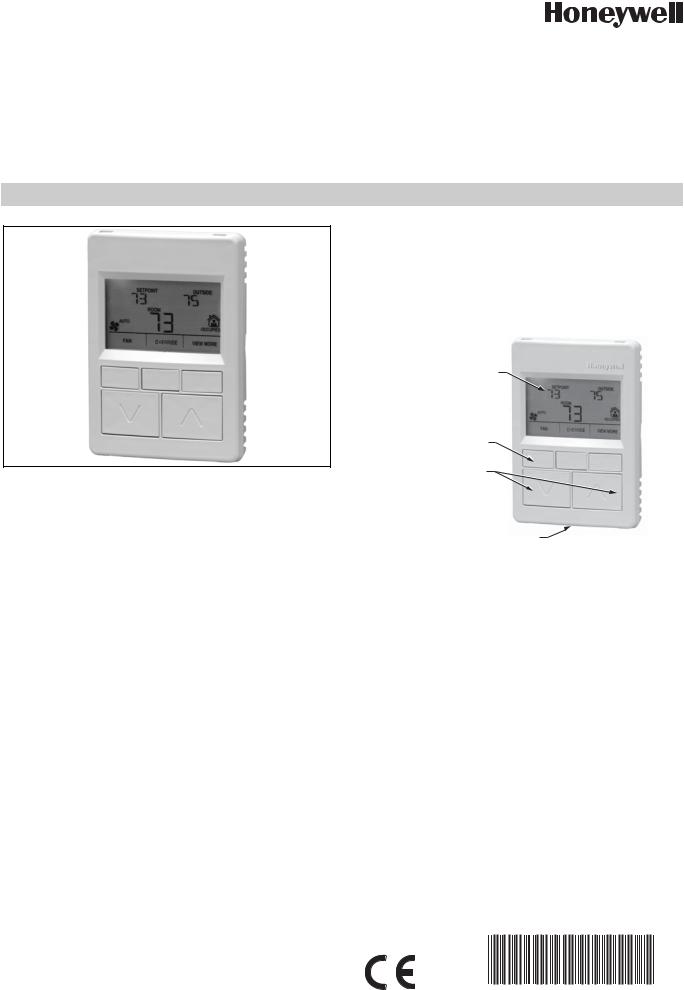
Zio®/Zio Plus LCD Wall Modules
TR70, TR71, TR75 with Sylk® Bus
OPERATING GUIDE
APPLICATION
The Zio TR70 Series (TR70, TR70-H, TR71, TR71-H, TR75, and TR75-H OS numbers) LCD Wall Modules provide an operator interface for monitoring and adjusting parameters in the wall module itself and in the programmable controller (refer to the Honeywell Spyder® User’s Guide, form 63-2662, or the ComfortPoint™ Programmable Controller User’s Guide, form 63-2663, depending on the programmable controller used) to which it is wired. The wall module may be customized and supports both a contractor and a tenant user interface.
NOTE: This document illustrates the wall module configuration process using information from the Honeywell Spyder User’s Guide (form 63-2662).
The wall module has a snap in mounting to a subbase that may be mounted on a wall, on a standard utility conduit box, or on a 60 mm wall outlet box. Wiring connections to the wall module are made through a cutout in the back of the wall module.
All models have a space temperature sensor, network bus jack, and an LCD panel with three softkeys and two Up/Down adjustment keys. Models with -H also include an onboard humidity sensor.
PREFACE
This Operating Guide is intended to provide configuration information (using the Niagara Workbench tool) and a general overview of the TR70 Series operator interface. Configuration
begins with “Initial Power-Up” on page 2, and the general overview begins with “Operating the Zio Wall Module” on page 19.
It is intended to guide you through the features and operation of the TR70 Series as you interface with the programmable controller and establish pre-programmed or custom configurations.
LCD PANEL |
|
SOFTKEYS (3) |
|
UP/DOWN |
|
ARROW KEYS |
|
NETWORK BUS PORT (ON BOTTOM OF CASE) |
|
|
M27344 |
Fig. 1. LCD Wall Module features. |
|
|
Contents |
Application ........................................................................ |
1 |
Preface ............................................................................. |
1 |
TR70 Series Features ....................................................... |
2 |
Compatibility ............................................................. |
2 |
Initial Power-Up ................................................................. |
2 |
Setup and Configuration ................................................... |
3 |
Initial Setup and Configuration .................................. |
3 |
Selecting the Wall Module ......................................... |
3 |
TR71/TR75 Labels .................................................... |
3 |
Navigation and Memory Usage ................................. |
3 |
Wall Module Configuration ........................................ |
4 |
General Settings ................................................... |
5 |
Categories and Parameters .................................. |
5 |
Home Screen Options ........................................... |
9 |
Occupancy and Override ...................................... |
10 |
Fan Command ....................................................... |
12 |
System Status and Command .............................. |
13 |
Schedule/Time ...................................................... |
14 |
Password ............................................................... |
15 |
Preview .................................................................. |
16 |
Completing the Setup and Configuration .................. |
17 |
Operating the Zio Wall Module ......................................... |
19 |
Contractor Mode Operation ...................................... |
19 |
Tenant Mode Operation ............................................ |
22 |
63-2719-03

ZIO®/ZIO PLUS LCD WALL MODULES
TR70 SERIES FEATURES
Table 1. TR70 Series Features.
|
Zio |
Zio |
Zio Plus |
Features |
TR70 |
TR71 |
TR75 |
|
|
|
|
Scheduling |
|
|
x |
|
|
|
|
Parameter Memory (bytes) |
1K |
2K |
4.9K |
|
|
|
|
Up to four Zios on Sylk |
x* |
x |
x |
|
|
|
|
Enumerated Values |
|
x |
x |
|
|
|
|
Setpoint Limits as NVs – linking |
|
x |
x |
now possible |
|
|
|
|
|
|
|
System and Fan command as NVs |
|
x |
x |
|
|
|
|
Password protection |
|
x |
x |
|
|
|
|
Firmware version/model visible on |
|
x |
x |
display |
|
|
|
|
|
|
|
0.5 and 5 value increments |
|
x |
x |
|
|
|
|
"-" and "/" characters in parameter |
|
x |
x |
names |
|
|
|
|
|
|
|
*A maximum of four Zios may be wired on a single Sylk bus, with no more than one TR70 per bus.
Compatibility
The TR70 Series LCD Wall Modules operate with the Sylk Enhanced Spyder Controller or the Sylk Enhanced ComfortPoint Controller. The table below provides compatibility information for each model. The TR71/TR75 can replace a TR70 in an installation where an upgrade to WEBsAX or Spyder or reprogramming is not desired. Features like scheduling, additional memory, etc. will not be available.
Likewise, a TR71 can be replaced by another TR71 or TR75 without reprogramming required. A TR75 can only be replaced with a TR75 where no reprogramming is desired.
INITIAL POWER-UP
IMPORTANT
1.Make sure the TR70 Series wall module is properly mounted and properly wired and connected to the programmable controller.
2.Refer to the Zio™ LCD Wall Modules TR70 Series with Sylk™ Bus – Installation Instructions, form 620271, for specific installation requirements.
Upon initial power-up before configuring the wall module, the LCD screen displays the phrase “PLEASE LOAd” in the Label/ Value area of Fig. 2. This phrase alternates with any onboard sensor display such as temperature. The TR71/TR75 also display the firmware revision number, model number and Sylk bus address as shown in Fig. 27.
Fig. 2 illustrates all the possible LCD Wall Module display elements. Only those elements pertinent to the current configuration and status actually display.
SYSTEM |
|
|
STATUS |
LABEL/ |
|
AREA |
||
OVERRIDE |
VALUE |
|
(8 CHAR.) |
||
INFORMATION |
||
|
||
CURRENT |
ENGINEERING |
|
DISPLAYED |
UNITS |
|
VALUE |
|
|
FAN |
OCCUPANCY |
|
INFORMATION |
STATUS |
|
SOFTKEY |
|
|
LABELS |
|
|
|
M27353 |
Fig. 2. TR70 Series Wall Module - LCD screen.
Table 2. Compatibility.*
Scenari |
Spyde |
Spyder |
Compatible |
|
|
o |
r Tool |
Firmware |
? |
Zio TR70/TR71/TR75* |
What can be done? |
|
|
|
|
|
|
1 |
5.200 |
Latest |
YES |
New TR71/75 functionality |
Ideal scenario |
|
+ |
|
|
available (if TR70 is present, |
|
|
|
|
|
then only TR70 |
|
|
|
|
|
functionality) |
|
|
|
|
|
|
|
2 |
5.200 |
Old |
YES |
Only with TR70 functionality |
Spyder firmware can be upgraded (this becomes scenario |
|
+ |
|
|
(TR71/75 can be used, but |
1) |
|
|
|
|
only TR70 functionality will |
|
|
|
|
|
be there) |
|
|
|
|
|
|
|
3 |
< 5.18 |
Latest |
NO |
Tool does not recognize the |
Spyder Tool can be upgraded (this becomes scenario 1) |
|
|
|
|
new Spyder |
Spyder firmware can be downgraded (this becomes |
|
|
|
|
|
scenario 4) |
|
|
|
|
|
|
4 |
< 5.18 |
Old |
YES |
Only with TR70 functionality |
Both Spyder firmware and Tool can be upgraded (this |
|
|
|
|
(TR71/75 can be used, but |
becomes scenario 1) |
|
|
|
|
only TR70 functionality will |
Spyder Tool can be upgraded (this becomes scenario 2) |
|
|
|
|
be there) |
Spyder firmware can be upgraded (this becomes scenario |
|
|
|
|
|
3) |
|
|
|
|
|
|
*The new Spyder tool (6.0 or greater) assumes the latest Spyder capability. At download, the Tool reads the brand/model of the connected Spyder and determines if it matches the features on the wire sheet. If old or new Spyder is programmed with aTR70, it can be physically replaced with a TR71 or TR75.
63-2719—03 |
2 |
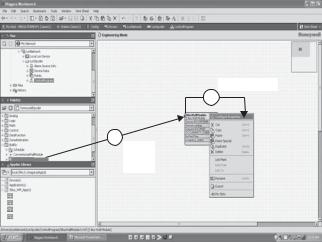
SETUP AND CONFIGURATION
Initial Setup and Configuration
Once the wall module is wired to the controller, you configure the wall module using the PC-based, Niagara Workbench Tool. Refer to the applicable programmable controller User’s Guide. (Refer to the Honeywell Spyder User’s Guide, form 632662, or the ComfortPoint Programmable Controller User’s Guide, form 63-2663, depending on the programmable controller used.) This tool is used to configure the wall module for either the Spyder or the ComfortPoint programmable controller.
Confirm Bus Address Setting
Check to ensure that the Wall Module’s bus address dial (located on the back of the module) is set to match the setting in the configuration tool. TR70 models can be set from 1–5 and TR71/TR75 can be set from 1–10 (0 on the Zio address dial is equal to 10 in the configuration tool). The address must be different for each device on the Sylk bus. Up to four Zios per Spyder are allowed with any combination of TR71/TR75s and up to three Zios are allowed if one or more is a TR70 model.
Selecting the Wall Module
You will use the Sylk S-Bus wall module function block from the Palette’s Built-In folder (see Fig. 3). This configuration has nothing programmed except the room temperature parameter and occupancy status.
1.Add the Sylk S-Bus Wall Module function block to the wire sheet via a left click, drag, and drop. See callout 1 in Fig. 3.
2.Right click on the S-Bus Wall Module function block to open the Configuration Properties menu. See callout 2 in Fig. 3.
3.Left click on the title, Configuration Properties. This action starts the Configuration Wizard. The Configuration Wizard steps (see Fig. 5 on page 4) are used to configure the wall module.
RIGHT CLICK
2
1
DRAG
SBusWallModule AND
DROP
VAV_Temp_NoBal_NwOvrdTime
VAV_Temp_MnMxBal_NwOvrdTime
VAV_Temp_KfacBal_NwOvrdTime
VAV_Temp_NoBal_AllOverride
M27820
Fig. 3. Niagara Tool Interface - S-Bus wall module selection.
ZIO®/ZIO PLUS LCD WALL MODULES
TR71/TR75 Labels
The TR71/TR75 allows the use of the following special characters in label fields such as Categories and Parameter Names: underscore ( _ ) to insert a space, hyphen ( - ), and forward slash ( / ). The TR70 allows use of the underscore ( _ ) character to insert a space.
Navigation and Memory Usage
The Honeywell Spyder Tool uses an intuitive, window-based interface. A Help button on each screen provides assistance with any entry or process.
IMPORTANT
Use the Help button to display context specific help for the current window or pane display. See the lower left corner of Fig. 6 on page 5 for the location of the Help button.
NOTE: At any time, clicking the Preview button (lower left of main window, see Fig. 6 on page 5) displays the updated wall module LCD as a pop-up. Preview simulates the actual wall module interface and allows you to verify the operation of the current configuration of the wall module. See “Preview” on page 16.
Navigation
Table 3 describes the navigation buttons at the bottom of the wall module window. See the bottom of Fig. 7 on page 5 for the location of these buttons. Buttons are greyed when unavailable.
|
Table 3. Navigation Buttons. |
|
|
Item |
Function/Use |
|
|
Help |
When clicked, this button provides context sensitive |
|
help for the currently selected item or parameter. |
|
|
Preview |
When clicked, this button displays the updated wall |
|
module LCD in a pop-up window pane. Preview is |
|
fully interactive and simulates the actual wall |
|
module interface as currently configured (see |
|
“Preview” on page 16 for details). |
|
|
Save to |
For new custom configurations and standard |
Library |
configurations. |
|
Clicking the button opens the Save to Library |
|
screen (shown in Fig. 25 on page 17). This action |
|
allows you to save the entire current wall module |
|
configuration. |
|
The Save to Library button is disabled until you |
|
change the configuration (application). After a |
|
change is made, you can save the new |
|
configuration into the library under a new name. |
|
|
Back |
Takes you backward one step in the wizard |
|
interface. |
|
|
Next |
Takes you forward one step in the wizard interface. |
|
|
Finish |
Clicking this button commits all changes to the |
|
database, closes the Configuration Wizard, and |
|
returns you to the wire sheet. |
|
|
Cancel |
Prompts you with a confirmation message. |
|
If you reply Yes, then all selections/entries made |
|
since the Save to Library button or Finish button |
|
was last pressed are ignored, and the wizard |
|
interface quits. |
|
|
3 |
63-2719—03 |
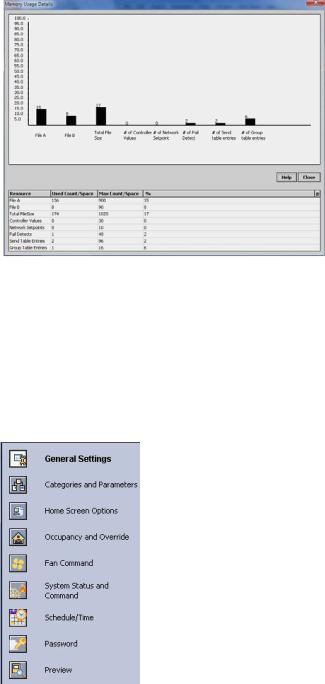
ZIO®/ZIO PLUS LCD WALL MODULES
SAVE BUTTON
A SAVE button is available on screens that allow entries or selections. It is enabled whenever any change is made on the screen, and allows you to save your selections/entries at any time. See the ROOMSP Details area of the Categories and Parameters window in Fig. 12 on page 7 for an example of the SAVE button.
Save is enabled whenever a change is made to the current page. When you press the SAVE button, the preview screen displays and your changes are reflected in the preview.
If you try to leave the current screen without saving (click another icon or press the Back or Next button) and have made changes, a warning message appears.
Memory Usage
The wall module has a fixed amount of memory available for configuration data. The TR70 has 1,020 bytes of memory, the TR71 has 2,000 bytes of memory, and the TR75 has 4,950 bytes of memory. To view the current memory use information click on the Memory Usage Details button. A new window opens and displays a bar graph indicating the percentage of current memory used in each memory category.
Each of the memory categories should be below 100%. See Fig. 4 on page 4.
NOTE: For a single Zio memory usage must be equal to or less than 100% in order to download the configuration to the programmable controller. If using multiple Zios, you should also check the Spyder Resource usage. Total Zio memory use is limited to 5K bytes on Spyder.
View the online help in the WEBs-AX Workbench to see troubleshooting tips for reducing memory usage in the TR70 Series if memory use is above 100%.
The following warning message displays when the memory usage is greater than 100%:
“Warning: Memory Limit Exceeded. The current wall module configuration requires more memory than the wall module model can support. You will need to change the configuration so that the memory usage is 100% or less before pressing the FINISH button.”
Fig. 4. Memory Usage Details screen.
Wall Module Configuration
To begin configuring the wall module:
1.Right click on the configuration’s function block to open the Configuration Properties menu.
2.Left click on Configure Properties. The Configuration Wizard opens. The Configuration Wizard steps (see Fig. 5) are used to configure the wall module.
See “General Settings”.
See page 5.
See page 9.
See page 10.
See page 12.
See page 13.
See page 14.
See page 15.
See page 16.
Fig. 5. Wall Module - Configuration Wizard window showing Menu selections only.
63-2719—03 |
4 |
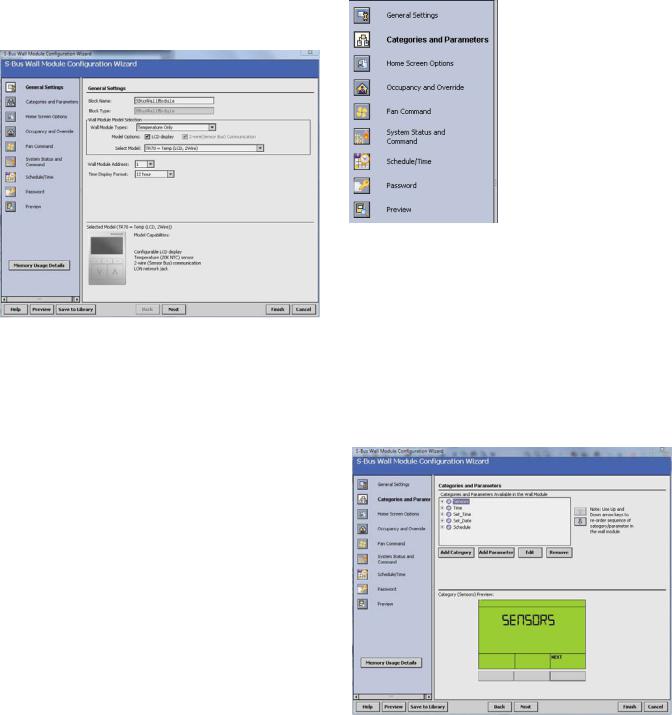
General Settings
Using Fig. 6 and Table 4 as a guide, configure the General Settings. An image of the selected model and its capabilities updates in the display at the bottom of the window.
Fig. 6. General Settings screen.
|
Table 4. General Settings. |
|
|
|
|
Item |
|
Function/Use |
|
|
|
Block Name |
|
The wizard displays S-Bus Wall Module. |
|
|
|
Wall Module |
|
Select the appropriate type (Temperature |
Type |
|
Only, or a combination of Temperature, |
|
|
and/or Humidity) from the drop down list. |
|
|
|
Model Options |
|
Click LCD Display. |
|
|
|
Select Model |
|
Select the appropriate model, TR70, |
|
|
TR71, or TR75, from the drop down list. |
|
|
|
Wall Module |
|
Select a unique address for each TR70 |
Address |
|
Series devices connected to the Spyder. |
|
|
TR70 can be set from 1-5 and TR71/ |
|
|
TR75s can be set from 1-10. The |
|
|
address selected must match the |
|
|
address setting at the wall module (using |
|
|
the rotary switches). If setting the TR71/ |
|
|
TR75 rotary switch to 0, set the address |
|
|
to 10 in the configuration tool. |
|
|
|
Time Display |
|
Select 12 or 24 hour format. |
Format |
|
|
|
|
|
If you are creating a customized configuration or modifying a pre-programmed configuration, continue with “Categories and Parameters” on page 5.
If you are using a pre-programmed configuration as is, continue with “Preview” on page 17.
ZIO®/ZIO PLUS LCD WALL MODULES
Categories and Parameters
I Categories and
Parameters selection from
Wizard Menu
The categories and parameters menu item allows you to create, edit, and delete categories and parameters.
ADDING A CATEGORY
Fig. 7 shows the categories listed in tree format in the main window where you can add, edit, or remove them. In the bottom pane, Category Preview (at the bottom of Fig. 7) shows the current selected item.
Clicking the Add Category button displays a details pane below the category and parameter tree as shown in Fig. 8.
NOTE: You can use the Remove button to delete unused categories and parameters to free up memory space.
Fig. 7. Category Preview.
CATEGORY DETAILS
When you select a category from the Categories tree list and click the Edit button, a details pane displays for that category (see Fig. 8 on page 6).
Here you can enter a category name and description. The number of parameters in this category are shown. The description text you enter is loaded to the controller but cannot be seen in the preview.
5 |
63-2719—03 |
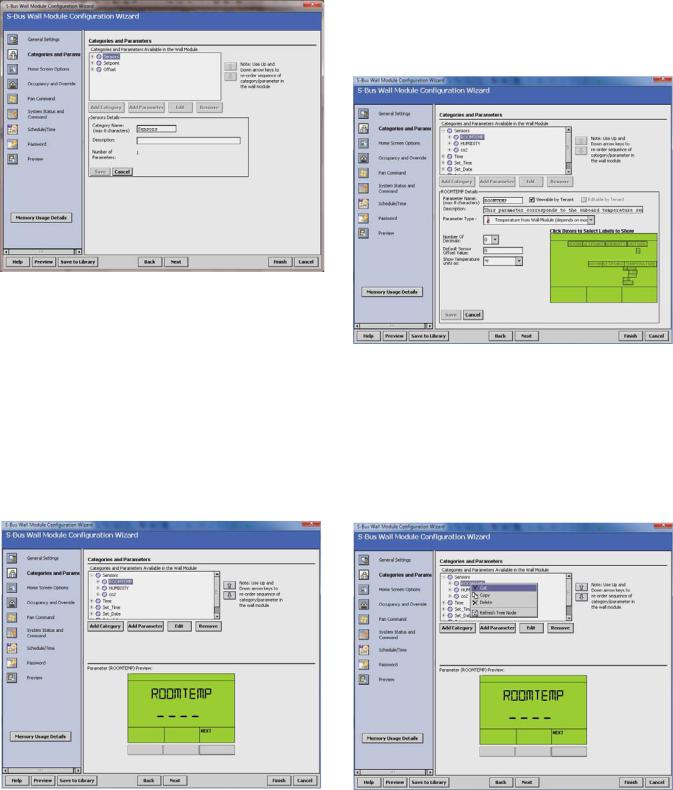
ZIO®/ZIO PLUS LCD WALL MODULES
Fig. 8. Adding a Category.
ADDING A PARAMETER
Fig. 9 shows the categories and parameters listed in tree format in the main window. The parameters are listed under each category. Click on the box next to the category item to expand that item in the tree. You can add, edit, or remove parameters under each category. In the bottom pane, Category Preview (at the bottom of Fig. 9) shows the current selected item.
Clicking the Add Parameter button displays a details pane below the category and parameter tree as shown in Fig. 10.
NOTE: You can use the Remove button to delete unused categories and parameters to free up memory space.
Fig. 9. Parameter Preview.
PARAMETER DETAILS
When you select a parameter from the tree list and click the Edit button, a details pane displays for that parameter.
Here you can select Viewable by Tenant and Editable by Tenant.
As an example, Fig. 10 shows the Details for the ROOMTEMP parameter. Here you would enter the description, select the parameter type from its drop-down list, enter the decimal accuracy, default sensor offset value, temperature units, and select the desired Home screen labels for the wall module.
Fig. 10. Adding a Parameter.
CUT/COPY/DELETE CATEGORIES AND PARAMETERS A right-click accessible context menu allows you to cut, copy,
paste, and delete parameters across categories. See Fig. 11.
You can also drag/drop parameters in the tree and the result is a copy/paste per standard Niagara behavior.
You can also click (highlight) any item in the tree and then click the Remove button to delete any selected parameter or its category.
Fig. 11. Cut/Copy/Delete Categories and Parameters.
63-2719—03 |
6 |

PARAMETER TYPES AND LIMITS
See Fig. 12 for an illustration of the Parameter Type drop down list. There is a limit to the number of parameters that can be configured. In addition to the parameter limit, there is also a memory limit (see “Memory Usage” on page 4).
Fig. 12. Parameter Type selection.
The individual parameters are defined as:
—Controller Value
•These are read-only inputs to the wall module from the controller and include system status and occupancy status, if configured. Controller Value parameters take up less memory than other parameters.
—Value From Wall Module
•These are outputs from the wall module such as room setpoint.
—Network Setpoints
•A network setpoint is a network variable from the controller that you want to view and change at the wall module.
—Sensors
•2 sensors (Temperature and Humidity)
•2 Sensor Offset Values (temperature and humidity)
See Table 5 for the individual parameter maximums.
IMPORTANT
You can not maximize all of these parameters together. The size of the data files limits the total number. See the memory usage tool by clicking on the Memory Usage Details button in the left pane of the Configuration Wizard.
ZIO®/ZIO PLUS LCD WALL MODULES
Table 5. TR70 Series Parameter Capacity Guidelines.*
Parameter Type |
TR70 |
TR71 |
TR75 |
|
|
|
|
Controller Value |
30 |
95 |
250 |
|
|
|
|
Value From Wall Module |
20 |
50 |
180 |
|
|
|
|
Network Setpoints |
10 |
50 |
125 |
|
|
|
|
*The TR71/TR75 may vary from these capacity numbers depending on label names, parameter limit reuse, and other devices that Zio interacts with on the Sylk bus.
NOTE: Network Variables need to be linked to the appropriate S-Bus wall module’s function block slots. See “Link Slots on the Wire Sheet” on page 18 for details.
PARAMETER OPTIONS
The TR71 and TR75 support additional parameter control. See Table 1 on page 2 for details.
ENUMERATED VALUES
Meaningful enumerated values can be displayed using the Enumerated option.
From the Add/Edit parameter window check the Enumerated box and click on the Define Enum Range as shown in Fig. 13.
Fig. 13. Click on the Enumerated Checkbox, then the Define Enum Range button.
Once in the Zio Enum Library dialog box (Fig. 14), click on the dropdown to see pre-defined facets or define your own. For more detailed information see the online help in the Configuration Wizard.
7 |
63-2719—03 |
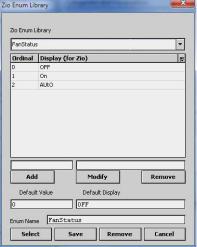
ZIO®/ZIO PLUS LCD WALL MODULES
Fig. 14. Select from the existing library or define enumerated values.
HIGH/LOW LIMIT PARAMETER LINKING
This option allows for changes to a setpoint's high or low limit directly at a Zio by linking the high and low limit to a related setpoint. For example, for an occupied heat parameter, you could assign the related unoccupied heat setpoint parameter
as the low limit and the occupied cooling setpoint parameter as the high limit. To assign a setpoint to another setpoint's high or low limit, click on the Browse button next to the Low Limit or High Limit field. From the Select Parameter dialog box you can select the appropriate setpoint.
This feature is an alternative to assigning a numeric value in the High/Low Limit fields, which require any change be made in the configuration tool and then loaded to Spyder.
Continue with “Home Screen Options” on page 9.
63-2719—03 |
8 |
